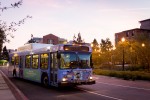Commuter students now have another option to get to campus with a new monthly subscription plan released by ride-share company Lyft.
Lyft released a monthly subscription plan earlier this month that charges passengers an upfront price of $299 per month to get 30 rides for up to $15 each, offering customers a long-term method of transportation.
Katie Rubino, a Lyft spokesperson, said Lyft introduced the service because of the success of its subscription pilot program, which launched in March.
“Lyft passengers asked for more options when it comes to transportation, and the all-access subscription plan allows them to seamlessly set up monthly payment options to enjoy more flexible, convenient and reliable rides,” Rubino said.
Dave Karwaski, senior associate director of UCLA Transportation, said he thinks the service may be viable for commuter students, but the majority of students who use Lyft to get to campus live closer than this service may be intended for.
Karwaski said that UCLA Transportation’s goal is to reduce carbon emissions, pollution and traffic within the UCLA community, and solo ride-sharing trips worsen these factors more than other methods of transportation.
“Driving alone is the least healthy way to commute – it adds to pollution and traffic congestion. So we try to entice people to take another mode (of transportation),” Karwaski said.
So far in 2018, students who drove alone to campus made up 23.5 percent of those commuting to UCLA, Karwaski said. This marks about a 2 percent increase from last year’s report, which also indicated a growth in ride-hailing commuters last year. Those who ride-hail comprised 3 percent of commuters this year.
Karwaski said he prefers other commuting options to solo ride-sharing trips because each ride adds four car trips to traffic congestion: one to pick up the passenger, one to transport them to campus and another two when the passenger leaves campus.
“We much prefer that people use uberPOOL or Lyft Line. This cuts down on the number of vehicle trips per person,” Karwaski said. “The gain is people take advantage of lower pricing, and two people use the car instead of one.”
He added that UCLA Transportation has already partnered with Lyft to offer a $4.99 flat rate for shared rides within 5 miles of campus starting last month. A similar pilot program was tested with uberPOOL earlier this year, but UCLA Transportation chose to establish a longer-term partnership with Lyft.
UCLA Transportation currently has partnerships with six transit agencies to offer options for commuter students that may cost less than the Lyft subscription.
A Flash Pass for the Culver CityBus and the Santa Monica Big Blue Bus costs $45 per quarter, around $15 per month. A co-pay option is also available.
“If you get on to the Big Blue Bus, which has a fare that’s usually $1.25, you can put in 50 cents and swipe your BruinCard – we pay the rest,” Karwaski said.
A Go Metro pass, which covers all Metro bus and rail lines, costs about $75 per quarter, around $25 per month. The pass also includes a free Flash Pass, Karwaski said.
The Bruin Bike Share program costs $7 per month, which allows riders to rent bikes for 90 minutes per day.
“This is a seamless system between Santa Monica, Beverly Hills, UCLA, and West Hollywood,” Karwaski said.
Electric scooters like those from Bird Rides, Inc. or Lime are also popular on campus but may not be cost-effective compared to other options, Karwalski said.
“Electric scooters are cool in that they’re sustainable,” Karwaski said. “It’s better to be on a scooter than the back seat of an Uber.”
